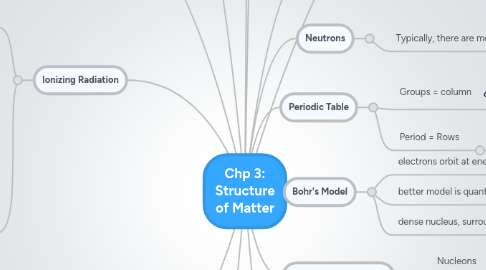
1. Ionization
1.1. Removal or addition of an e-
1.2. Ionization Potential
1.2.1. 34 eV to ionize tissue atoms
2. Atomic Structure
2.1. Mostly empty space
2.2. Most of Mass contained in Nucleus
2.3. Electron orbit are grouped into shells
2.3.1. Determines atoms chemical reaction
2.3.1.1. represent different Electron Binding energies
2.3.1.1.1. 7 shells, K - Q
2.3.1.1.2. Max e- per shell = 2n(squared), n = shell #
2.3.2. No outer shell can contain more than 8 e-
2.3.2.1. 8 = very chemically stable
3. Units to Know
3.1. Atomic Mass Unit (AMU)
3.1.1. Exact Mass of neutral atom
3.2. Atomic Mass Number (A)
3.2.1. # of protons and neutrons
3.3. Atomic Mass
3.3.1. Relative mass of an atom
3.3.1.1. determined by measurement
3.4. Atomic Number (Z)
3.4.1. # of protons
4. Electrons
4.1. equal to # of protons
4.2. Electron Binding Energy (Eb)
4.2.1. Strength of attachment of e- to nucleus
4.2.2. Closer to nucleus = higher Eb
4.2.2.1. so K shell has most Eb
4.2.3. Determined by atom, higher the mass, higher the Eb
4.3. Kept in orbit by centripetal force (center-seeking force)
4.3.1. Centrifugal force (fly from center) balances it
5. Types of Atoms
5.1. Atom
5.1.1. Typical number of neutrons and proton, same #of electrons and protons, so no charge
5.2. Isotope
5.2.1. Same # of protons, but different of Neutrons
5.2.1.1. aka ,same Z, but different A
5.2.1.1.1. Still have the same chemical reaction
5.3. Isotones
5.3.1. Same number of neutrons, dif # of protons
5.4. Isomers
5.4.1. Same # of nucleons, but different nuclear energy state
5.5. Isobars
5.5.1. Same # of nucleons, but dif number of protons & neutrons
5.5.1.1. When radioactive elements decay, the daughter atom is a different element than the parent atom
5.6. Ionized
5.6.1. Atom with +/- an e-
5.6.1.1. has a charge
6. Ionizing Radiation
6.1. Particulate Radiation
6.1.1. Alpha
6.1.1.1. high velocity, transfers energy to e- easily, but loses energy quickly, so short range
6.1.1.2. Only from heavy elements
6.1.1.3. Helium nucleus (2P, 2N), 2 positive charge
6.1.1.4. Nearly Harmless, because only reaches superficial tissue, except when it is inside body (lung)
6.1.2. Beta
6.1.2.1. Light particles, with (A) of 0 and only one +/- charge
6.1.2.2. an electron emitted from the nucleus of a radioactive atom
6.1.2.3. range is longer than alpha (1-2 cm in tissue)
6.2. Electromagnetic Radiation
6.2.1. X-rays
6.2.1.1. produced from e- shells
6.2.2. Gamma Rays
6.2.2.1. emitted from nucleus
6.2.3. Photons
6.2.3.1. have no mass, no charge, travel at speed of light, energy disturbances in space.
6.2.3.2. unlimited range of matter
7. Periodic Table
7.1. Groups = column
7.1.1. each group has a similar chemical reaction
7.1.2. same # of electrons in outermost shell
7.1.2.1. ex: Al is in 3rd group = 3 electrons in outershell
7.2. Period = Rows
7.2.1. # of electron shell
7.2.1.1. ex: Al is in 3rd period = M shell
8. Bohr's Model
8.1. electrons orbit at energy levels
8.2. better model is quantum chromodynamics
8.3. dense nucleus, surrounded by electrons
9. Fundamental Particles
9.1. Nucleons
9.1.1. Protons (+)
9.1.1.1. Both have 2000x mass of e-
9.1.2. Neutrons (no charge)
9.1.2.1. Both have atomic mass # = 1
9.2. Electrons (-)
10. Neutrons
10.1. Typically, there are more N than P
11. Protons
11.1. Determines chemical element
11.2. equal to # of Electonrs
12. Molecules
12.1. formed by atoms of various elements
12.2. chemical compound
12.2.1. any quantity of one type of molecule
12.3. Chemical Bonding
12.3.1. Covalent bonds
12.3.1.1. Atoms of the molecule share electrons Ex: water (H2O)
12.3.2. Ionic Bonds
12.3.2.1. One atom gives up an e- to another atom Both end up with a net charge: 1 is + , one is – Since opposites attract, these two ionized atoms have an ionic bond Ex: Salt (NaCl)
13. Radioactivity
13.1. atoms in an abnormally excited state from unstable nucleus
13.2. Radioactive Disintergration or Radioactive decay
13.2.1. when an atom emits particles and energy to turn itself into another atom so it can be stable
13.2.2. Ex: Uranium radium radon
13.2.3. particles emitted
13.2.3.1. Alpha Particles
13.2.3.1.1. 2 protons and 2 neutrons bound together (4 units of mass) atoms must be very unstable to emit alpha
13.2.3.2. Beta Particles
13.2.3.2.1. electron from nucleus escapes atom, while neutron turns into proton
13.2.3.2.2. so, Z is increased, while A stays the same, but atom changes to dif element
13.2.3.2.3. Much more common than alpha
13.2.3.3. Gamma Rays
13.2.3.3.1. Most beta and alpha emissions result in these as well
13.3. Radionuclides
13.3.1. nuclei that undergo radioactive decay
13.4. Radioisotopes
13.4.1. Radioactive atoms w/same #of protons, changed by radioactive decay resulting in emission of ionizing radiation
13.5. Half-Life
13.5.1. Time it takes for the quantity of radioactivity to be reduced to ½ its original value Can take many thousands of years 1 Ci/Bq = 3.7 x 1010 atoms disintegrating per second
13.5.1.1. never quite reaches zero
